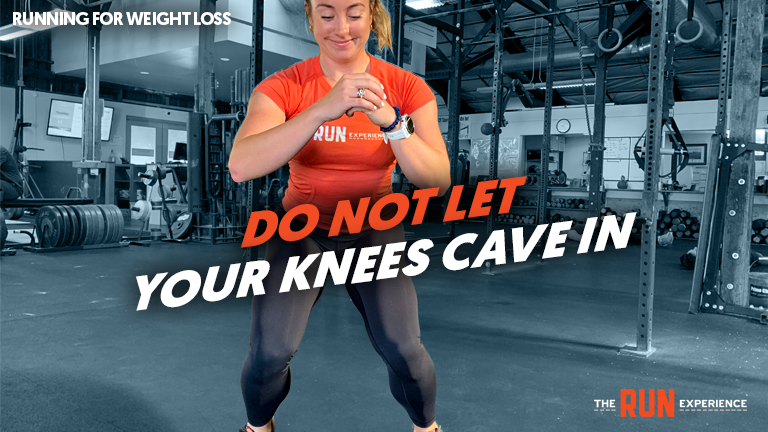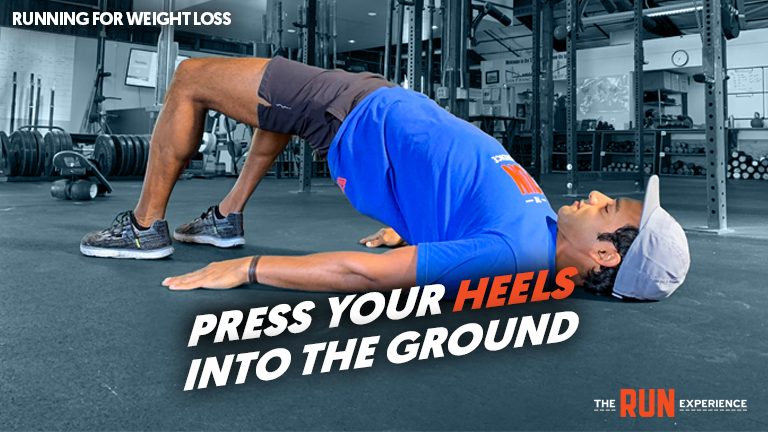The Ultimate Weight Loss Running Plan (Top Tips & Schedule)
Our ultimate weight loss running plan to learn how to lose weight with a running program: try the tips and a running schedule for weight loss.

Running can be your best friend on your weight loss journey, so long as what you’re doing is sustainable.
Here at The Run Experience, we believe that everyone’s a runner. The key is to start slow and easy and keep your goals doable. We want to avoid burnout and injury at all costs.
That's why we've designed this ultimate weight loss running plan. It provided you with the tips and best practices you need to create a sustainable running journey.
Ultimate Weight Loss Running Plan
This weight loss running plan is designed to give you a structured and sustainable approach to running and weight loss. We want to make your running effective but also enjoyable and injury-free. Below, we'll dive into the key steps in creating a personal weight loss running program tailor-made for you.
1. Establish Clear and Achievable Goals
Setting clear, realistic, and measurable weight loss and running goals will serve as your roadmap throughout this journey. Define your weight loss target, timeframe, and running milestones in a manner that is achievable and in alignment with your current fitness level. Ensure that your goals are S.M.A.R.T - Specific, Measurable, Achievable, Relevant, and Time-bound to keep you motivated and on track.
2. Create a Balanced Running Schedule
Developing a running schedule that balances intensity, duration, and rest is pivotal for effective weight loss. Incorporate a mix of running workouts, including steady-state runs, interval training, and long, slow runs, to optimize calorie burn and enhance your running capacity. Ensure that your schedule progressively increases in intensity and duration to continuously challenge your body.
3. Integrate Strength Training
Incorporating strength training into your running plan is crucial for enhancing muscle strength, improving running efficiency, and preventing injuries. Focus on exercises that strengthen your core, legs, and upper body to support your running mechanics. Strength training also aids in maintaining muscle mass, ensuring that weight loss predominantly comes from fat loss.
4. Prioritize Nutrition
Aligning your nutritional intake with your weight loss and running goals is paramount. Focus on a balanced diet that fuels your runs and aids recovery while creating a calorie deficit conducive to weight loss. Consider consulting a nutritionist or utilizing a food diary to ensure that your nutritional choices support your physical activity and weight loss goals.
5. Focus on Adequate Recovery
Allocating time for adequate recovery is essential to prevent injuries and allow your body to heal and adapt. Incorporate rest days and engage in recovery practices such as stretching, foam rolling, and perhaps even yoga to facilitate muscle recovery and enhance flexibility. Ensuring sufficient sleep is also crucial to support recovery and overall health.
6. Monitor Progress and Adapt the Plan
Regularly track your progress in terms of weight loss, running performance, and overall fitness. Utilize tools and metrics such as running apps, fitness trackers, and regular weigh-ins to monitor your journey. Be prepared to adapt your running plan based on your progress, ensuring that it continues to challenge you and is aligned with your evolving fitness level and weight loss goals.
Running Schedule for Weight Loss
Now that you've established a strong foundation for your weight loss running plan, you're ready to look at an example running schedule for weight loss. Obviously, your schedule and life demands will look different, and you'll need to tailor this schedule to your lifestyle.
That's fine and dandy.
We're just going to provide you with an example so that you know what to look for and prioritize while building you're own schedule.
Remember, we want to start and progress slowly. Your weight loss journey isn't a race. Slow and steady wins here. Be patient and resist the urge to skip phases or push yourself harder than your body is ready for.
Weeks 1-2: Establishing a Running and Strength Base
- Day 1: 20-minute brisk walk
- Day 2: Full-body strength training (20 minutes)
- Day 3: 10 minutes of running, 10 minutes of walking
- Day 4: Rest
- Day 5: 15 minutes of running, 5 minutes of walking
- Day 6: Full-body strength training (20 minutes)
- Day 7: Rest or light activity (e.g., yoga)
Weeks 3-4: Building Consistency in Running and Strength Training
- Day 1: 20 minutes of running
- Day 2: Upper body strength training (20 minutes)
- Day 3: 25 minutes of running
- Day 4: Rest
- Day 5: 20 minutes of running
- Day 6: Lower body strength training (20 minutes)
- Day 7: Rest or light activity
Weeks 5-6: Introducing Interval Training and Targeted Strength Work
- Day 1: 30 minutes of running
- Day 2: Core and stability training (20 minutes)
- Day 3: Interval training: 5-minute warm-up, 10x(1 minute running, 1 minute walking), 5-minute cool down
- Day 4: Rest
- Day 5: 30 minutes of running
- Day 6: Full-body strength training (25 minutes)
- Day 7: Rest or light activity
Weeks 7-8: Enhancing Intensity in Both Running and Strength Training
- Day 1: 35 minutes of running
- Day 2: Upper body strength training (25 minutes)
- Day 3: Interval training: 5-minute warm-up, 10x(2 minutes running, 1 minute walking), 5-minute cool down
- Day 4: Rest
- Day 5: 40 minutes of running
- Day 6: Lower body strength training (25 minutes)
- Day 7: Rest or light activity
Weeks 9-10: Solidifying Endurance and Strength
- Day 1: 45 minutes of running
- Day 2: Core and stability training (25 minutes)
- Day 3: Interval training: 5-minute warm-up, 8x(3 minutes running, 1 minute walking), 5-minute cool down
- Day 4: Rest
- Day 5: 50 minutes of running
- Day 6: Full-body strength training (30 minutes)
- Day 7: Rest or light activity
Weeks 11-12: Optimizing Weight Loss Running and Strength Training
- Day 1: 55 minutes of running
- Day 2: Upper body strength training (30 minutes)
- Day 3: Interval training: 5-minute warm-up, 6x(4 minutes running, 1 minute walking), 5-minute cool down
- Day 4: Rest
- Day 5: 60 minutes of running
- Day 6: Lower body strength training (30 minutes)
- Day 7: Rest or light activity
We crafted this 12-week running schedule for weight loss to build your running and strength training capacity. Complement this schedule with adequate nutrition and recovery practices to optimize results. Always listen to your body and adjust the schedule as needed, ensuring that your weight loss journey is not only effective but also sustainable and enjoyable!
Tips for Running to Lose Weight
1: Understand the Difficulties of Weight Loss and Weight Loss Tips
Before diving into a running training program to achieve your weight loss goals, it is important to take a look at previous experiences, and understand what works and what does not.
Typically, those interested in running for weight loss fall into one of two categories.
The first are those who went all in on a training program and simply burnt out.
Whether you tried a running program before, just stuck to strength training or cardio, or mixed it all up; it didn’t last.
Maybe you got injured, or maybe you put so much energy into your program that you had to sacrifice other things in your life, and doing so was not sustainable.
The second category are those who have not tried a specific training program yet, because they feel they need to lose a certain amount of body weight before even getting started.
After all, following any exercise program is tough on the body no matter your body weight, and maybe you just wanted to slim down before starting to make the training easier once you do get started.
The good news is, no matter which of the above categories you fall into, the solution is the same. Your weight-loss journey is simply going to require a sustainable exercise program.
This means that your exercise plan will focus on small, gradual improvements so that you don’t burn out, and so that you can begin the exercise plan at any weight.
We’re not going to ask for any crazy diet plan or calorie deficit. Rather, we’re going to utilize running, strength training, and mobility to keep your body feeling healthy and pain-free. This way, you will stay motivated to keep going even after the initial buzz wears off.
2: Use A Workout Checklist on Workout Days
Believe it or not, easy weight loss is possible. And while it may seem counterintuitive, easy weight loss requires being easy on yourself. Setting extreme, unsustainable goals almost guarantees burnout.
We want our goals to be manageable, so that it does not feel like our weight loss journey is disrupting the rest of our lives.
An easy way to keep your workouts sustainable is to just run through a quick checklist every time you workout. The checklist will include the following:
Heart Rate
Your heart rate during any given workout should be raised above your resting heart rate.
Now, we’re not saying you need to feel totally gassed every time you workout. But we do need just a bit of what we’ll call “heart rate discomfort.” Just get outside of your resting, normal range.
Sweat
Sweating is by no means the line between a good or bad workout. However, for most of us, sweating is a good indicator that we are outside of our comfort zone.
And again, we’re not saying you need to be drenched in sweat after every workout. But add it to the checklist to ensure you are getting out of your comfort zone and doing hard work.
Abnormality
A body workout should require your body to do things it normally does not do. This is how we will see change.
This is especially true for those of who sit at a desk or in a car for most of our day. A workout should include movements that you do not do in your daily life.
Think about “waking up” muscle groups that tend to fall asleep during your daily life. These groups might include your glutes, biceps, triceps, hamstrings, abdominals, quads, calves, or back muscles.
Not every workout needs to hit the whole body necessarily, but be sure your workout contains movements that are abnormal when compared to your daily routine. Wake up some of those sleepy muscles.
Leave Your Comfort Zone
Make sure you leave your comfort zone for at least a few moments during every workout. As described above, this might occur by getting your heart rate up.
If you are doing a strength training workout, this might occur by fatiguing a particular muscle group.
Getting out of your comfort zone aids weight loss and change by making you both mentally and physically stronger. Each time you get out of your comfort zone, you are proving to your mind and body what you are capable of.
So, on your next workout, your body is ready to continue improving, because you taught yourself on the last workout that you can survive discomfort.
Your body will subtly adapt to the changes and challenges you throw its way.
Endorphin Rush
This one might not come right away. But, after a couple of successful workouts that meet numbers 1-4 above, you will notice a burst of energy after a hard effort.
This is an endorphin rush, and it’s a reward for your body to you after a hard effort.
By adding this to the checklist, you will motivate yourself to keep going. Feeling proud of yourself will make it easier to sleep at night and keep moving forward.
3: Map It Out One Week at a Time to Maximize Fat Loss
This does not need to be exact. But a week is a nice, manageable chunk of time to map out.
Because we are focused in this article on running for weight loss, below is a general, loose plan to follow.
On 3 days out of the week, incorporate a walk, run, or a combination of the two.
On 2 days out of the week, perform a strength training workout. You can use weights or just your body weight. You can take a class or design your own workout. You can do use a circuit format, or just a number of designated reps per exercise, going one time through.
For an idea to get started, check out this example of a strength training workout.
And then every day (or almost every day), be sure to mobilize or stretch. This is going to improve recovery and minimize soreness, so that injury and soreness do not hold you back.
What does a walk/run day look like?
Developing a concrete plan for when you head out the door will make your weight loss program so much easier.
To simplify things, here are two walk/run workouts that are easy to follow to get your weight loss plan started.
Walk/Run Session 1
Good news… it’s only 10 minutes! For this workout, head out for 10 minutes alternating:
– 90 seconds walking
– 30 seconds jogging
You will end up doing that set five times over the 10 minutes. And jogging can mean anything! You can even power walk for the 30 seconds if you’re not up to jogging yet.
Walk/Run Session 2
For this workout, try to find a hill. It does not need to be steep, just an incline to help get your heart rate up a bit.
You could even do this on a treadmill. For the portions going up the hill, set your incline to 4% or 5%.
For this session, you’ll do a 1-minute power walk up the hill, and then walk or jog down. You will repeat this for 6-8 rounds depending on how you’re feeling, and how much time you have.
The great thing about both of these workouts is that they are easily scalable as you improve on your weight loss journey and continue to lose body fat.
For example, for Workout 1, you could add an extra 10 minutes to the workout, or you could reduce your walk time by 15 seconds and increase your jogging time by that much instead.
And for Workout 2, feel free to add in rounds, or bump your power walk up to a jog when going uphill.
Strength Training Workout
Next, let’s take a look at an example strength workout that is going to hit every item on your workout checklist.
The format here is going to be four movements, for 3-5 rounds depending on how you feel. Rest for about one minute in between each round, and feel free to take additional rest as needed.
1. 10 Air Squats

Start with your feet just outside of hips’ width with your toes pointed straight ahead. Keeping your arms out in front of you and your chest up, squat down as low as you can go without your chest falling forward.
For added assistance, add a seat behind you that you can tap each time you’re at the bottom, so that you know you’re going low enough.

2. Plank Hold

Next, we’re going to hold a plank, or the top of a push-up position. We’re going to hold here for 30 seconds.
For added assistance, place your hands on a platform of some kind, so that your hands are higher than your feet.
3. 10 Glute Bridge Raises

Laying on your back, place your feet flat on the ground. Press your heels down into the ground, and lift your hips up to the sky, and then lower them back down. Repeat this movement 10 times.
4. 5 Elevated Push-Ups
Lastly, take 5 push-ups with your hands on an elevated surface. For a modified version, lower down to your knees.
Stretch and Mobility Example
4: Use Tools to Hold You Accountable for Your Lifestyle Change
Lastly, lean on tools and friends to hold you accountable. If you prefer your weight loss journey to be more individual, try keeping a training journal where you right down your workouts ahead of time, and check them off as you go through your week.
You can even make notes on how the workout went that day. Over time as the workouts get easier, this will be a cool way to see how much progress you’ve made.
If you want to share your journey, tell friends or members of an online community about your goals. If you have a workout planned, share it! This way your community can check in on how it went, and it will hold you accountable to stick to your training plan.
And lastly, believe in yourself. Play the long game. Trust the process. You’ve got this, just be disciplined and patient!
Let Us Help You Lose Weight With Our Running Program
Running can be a fantastic tool on your weight loss journey, but it’s essential to make it sustainable and enjoyable. At The Run Experience, we’re here to support you every step of the way. Our ultimate weight loss running plan is designed to help you set achievable goals, create a balanced schedule, integrate strength training, prioritize nutrition, and focus on recovery.
By following our plan, you'll be on your way to a healthier, fitter you.
Are you ready to take the next step? Join our community and let us help you reach your weight loss goals with personalized running programs, expert coaching, and a supportive network of fellow runners. Download our app for access to daily video workouts, injury prevention tips, and complete training plans tailored to your needs.
Let’s do this together. Start your weight loss journey with us today and experience the joy of running!
